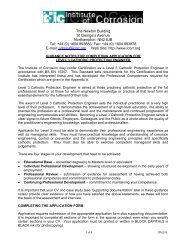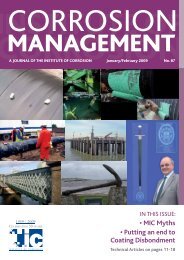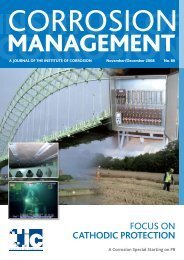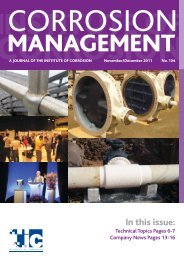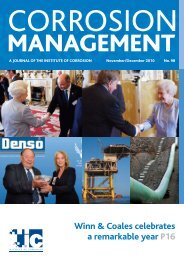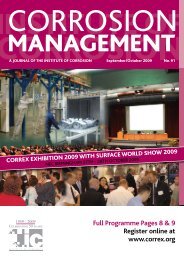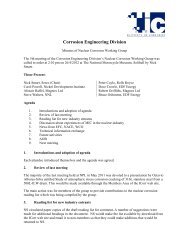In this issue: - the Institute of Corrosion
In this issue: - the Institute of Corrosion
In this issue: - the Institute of Corrosion
You also want an ePaper? Increase the reach of your titles
YUMPU automatically turns print PDFs into web optimized ePapers that Google loves.
TECHNICALARTICLEhow <strong>the</strong> corrosion cells are created which leadto corrosion. 21A basic corrosion cell consists <strong>of</strong>:n Anode site, where corrosion occurs andfrom which current flows;n Cathode site, where no corrosion occursand to which current flows;n Electrolyte, a medium capable <strong>of</strong>conducting electric current by ioniccurrent flow (i.e. water, or saturatedconcrete);n Metallic path, connection between <strong>the</strong>anode and cathode, which allows currentreturn and completes <strong>the</strong> circuit.and <strong>the</strong>y are all required for corrosion tooccur. The driving force behind corrosion isa corrosion cell that is electrochemical innature; that is, involves chemical reactionsand <strong>the</strong> transport <strong>of</strong> electrons. The drivingforce behind <strong>the</strong> corrosion cell is a potentialor voltage difference between <strong>the</strong> anode andcathode, which leads to corrosion to occur.The corrosion cell (i.e. potential difference)can be created if:n Unprotected steel surface is in contactwith electrolyte which could be ei<strong>the</strong>r afilm <strong>of</strong> moisture or seawater;n Dissimilar metals are in contact or joinedtoge<strong>the</strong>r;n A detail exists that allows penetration,retention or trapping <strong>of</strong> moisture or water;andn Steel member is constantly exposed towetting and drying conditionsThe above are some examples <strong>of</strong> <strong>the</strong> corrosioncell creators in <strong>the</strong>ir simplest form and if <strong>the</strong>formation <strong>of</strong> corrosion cell is prevented, <strong>the</strong>ncorrosion can be prevented and <strong>the</strong> intendeddesign life <strong>of</strong> <strong>the</strong> marine structure can beachieved. We name <strong>this</strong> approach “prevent <strong>the</strong>formation <strong>of</strong> corrosion cell principle”. <strong>In</strong> orderto accomplish <strong>this</strong>, <strong>the</strong> designer must havean understanding and awareness <strong>of</strong> corrosioncell formation during <strong>the</strong> design and detailingprocess <strong>of</strong> <strong>the</strong> structure. We will explore <strong>this</strong>in some detail to understand <strong>the</strong> mechanismand formation <strong>of</strong> <strong>the</strong> corrosion cell and how itcan be prevented.2.1.3.1 Unprotected steelsurface in contact wi<strong>the</strong>lectrolyteAtmospheric zone adjacent to jetty is ladenwith wind-swept fine particles <strong>of</strong> sea salt(i.e. sodium chloride) that is highly corrosiveand deposits on nuts and bolting and surface<strong>of</strong> <strong>the</strong> structure surfaces 22 & 23 . The sodiumchloride could be dispersed ei<strong>the</strong>r as liquidaerosol or dry particles 24 , and it will providecatalyst for corrosion which is known to occurat relative humidity as low as 35% 25 .When <strong>the</strong> unprotected steel surface is contactwith an electrolyte such as seawater or a film<strong>of</strong> moisture containing dissolved salts, anelectrochemical process occurs which leadsto corrosion 26 . All metals in contact with anelectrolyte have an electrochemical potentialthat is specific for <strong>the</strong> metal/electrolytecombination. Different metals have differentpotentials in a specific electrolyte. At <strong>the</strong>surface <strong>of</strong> one metal in an electrolyte, <strong>the</strong>reare anodic and cathodic areas, which havesmall differences in potential. They form activeelectrochemical cells in which current flowsfrom <strong>the</strong> anodic areas into <strong>the</strong> electrolyte, andfrom <strong>the</strong> electrolyte into <strong>the</strong> cathodic areas.The prime example <strong>of</strong> <strong>this</strong> scenario is <strong>the</strong>primary and secondary steel members <strong>of</strong> ajetty structure and if it is left unprotected, orbadly protected, cell corrosion will be createdon its surface which will lead to corrosion.Hence to prevent <strong>the</strong> creation <strong>of</strong> <strong>the</strong> corrosioncells, all <strong>the</strong> primary and secondary membersas shown in Figure 2 are coated with an anticorrosionsystem to prevent <strong>the</strong> creation <strong>of</strong><strong>the</strong> corrosion cells.2.1.3.2 Dissimilar metalsare in contact or joinedtoge<strong>the</strong>rAlthough dissimilar metals such as stainlesssteel anchor bolts aren’t encouraged for usein marine environment, <strong>the</strong>re are places thatstainless steel anchor bolts are used due to<strong>the</strong>ir higher yield strength. Where <strong>the</strong>re arestainless steel anchor bolts in concrete, <strong>the</strong>re ispossibility <strong>of</strong> corrosion <strong>of</strong> <strong>the</strong> bolts, base plateor embedded carbon steel reinforcement andit is a concern for <strong>the</strong> designers as cathodicprotection. Therefore proper detailing <strong>of</strong><strong>the</strong> holding down bolts by understanding<strong>the</strong> corrosion mechanism is <strong>the</strong> key for <strong>the</strong>preventing corrosion in <strong>the</strong> structure.Due to <strong>the</strong> nature <strong>of</strong> <strong>this</strong> Jetty Structureand its design all <strong>the</strong>se details are in <strong>the</strong>atmospheric zone <strong>of</strong> <strong>the</strong> structure and figures3 and 4 provide two examples <strong>of</strong> stainlesssteel holding bolts.2.1.3.3 A detail that allowspenetration, retention ortrapping <strong>of</strong> moisture orwaterGood design detailing is <strong>the</strong> first and mostimportant step in corrosion control andimproper detailing will create a corrosioncell in maritime structures that will leadto corrosion. The codes for steel structuresprovide general guidance on use <strong>of</strong> structuralsteel and good detailing but do not providean in depth knowledge <strong>of</strong> <strong>the</strong> subject. BS ENISO 12944-3 guidance for <strong>the</strong> prevention <strong>of</strong>corrosion by good design 27 detailing statesthat “<strong>the</strong> design <strong>of</strong> a structure can affect <strong>the</strong>durability <strong>of</strong> any protective coating appliedFigure 3. Stainless steel holding down bolts <strong>of</strong> <strong>the</strong> concrete deckguard rails (Image courtesy <strong>of</strong> Mac Connell Dowell)are not isolated.are not isolated.are not isolated.Figure 4. Detail <strong>of</strong> holding down bolts for a stanchion (Image courtesy <strong>of</strong> Mac Connell Dowell)if <strong>the</strong> stainless steel boltsif <strong>the</strong> stainless steel boltsif <strong>the</strong> stainless steel bolts21



